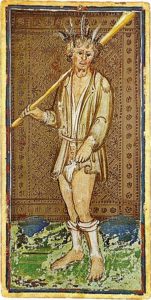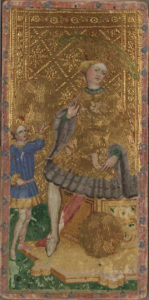
This is the third of a three-part post on the process used to paint the earliest extant tarot cards, made in fifteenth-century northern Italy. Part I: The Studio | Part II: Preparing and designing the tarot cards | Part III: Painting and gilding the tarot cards
Gilding, if part of the design of the artwork, was completed before the paint was laid down.
The artist would cover the areas to be gilded with bole, a reddish clay to which the goldleaf would adhere and which would provide a slightly soft cushion for embossing the gold. This red clay is sometimes visible where the gilding has worn off the cards; for example, on the left margin of the Visconti-Sforza Fool card. After the bole was applied, the work could rest, as the master Cennini told his artists in his 1437 treatise Il Libro dell’ Arte, waiting for “when some mild, damp weather comes along, and you want to do some gilding.”
The gold leaf itself was procured from a goldsmith. The bole was re-moistened as each whisper-thin leaf was laid down with tweezers. A specialized tool burnished the gold smooth and shiny. More burnishing would make the gold darker, which may account for the differences in the backgrounds of cards from the same groups. Although the gilded areas of the cards go “behind” the painted areas, the gilding does not actually extend under the paint, which adheres not to the bole but to the gesso first used to prepare the paper’s surface.
Cennini describes tools and stamps for embossing the gold “so that, with imaginative feeling and a delicate touch, you may work out foliage ornaments on a gold ground, and make little angels and other figures….” Surprisingly, stamps were not always used for the repetitive patterns on the tarocchi cards. For example, the sunbursts and the dot clusters on the backgrounds and borders of the Cary-Yale cards seem to have been made stroke by stroke.

Gilding demanded great finesse. Though the work would seem tedious, Cennini described stamping and incising gilded designs as “one of our most delightful branches.”
After gilding, the artist painted the cards. Cennini describes the process of laying down the paints, delicately touching in each color, from dark shades to light, with “pure white lead” used for highlighting. The paint, called egg tempera, comprised pigments tempered with egg yolk. More delicate than oil paint, which would soon dominate painting, egg tempera cannot be modeled, and it provides less flexibility in layering colors. However, it produces very beautiful, brilliant and pure hues. The colors used for the Visconti-Sforza tarocchi have maintained their richness, especially the blues.
It was not unusual for the patron to monitor the use of expensive pigments. Ultramarine blue, for example, was made of powdered lapis lazuli; often the relatively cheap “German blue” was used instead, being made merely of carbonate of copper.
Whether working singly or as a group of masters and apprentices, hopefully the tarocchi artists took as much joy in their craft as did the master Cennini, who compared panel painting favorably to fresco painting. “And with this you have enough time so that you can get up from your work and rest yourself for a while, and reflect upon this work of yours. Work on panel wants to be done with much enjoyment.”
RENAISSANCE ITALY: GLORY, BEAUTY, GREED, WAR.
A POWERFUL HOLY WOMAN. THE INQUISITION….
A novel based on the true story of the Popess card of the tarot.
BUY: Signed by author, free shipping in US
BUY: bookshop.org | Amazon US | Amazon CA | B&N | indiebound
“Enchanting & richly historical, heart-wrenching & intoxicating.” —Stuart R. Kaplan, author Pamela Colman Smith.
“A storytelling treasure. The sights, smells, feel of Renaissance Italy seep from every pore of the story.” —Ron Andre, A Matter of Fancy
SOURCES: Fool image via Wikipedia Collection Pierpont Morgan Library & Museum | King of Coins image via Wikipedia Collection of Beinecke Library, Yale University | Cennini: The Craftsman’s Handbook. Translated by Daniel V. Thompson, Jr. New York: Dover, 1954.

Pingback:THE EARLY TAROT ARTISTS AT WORK | Part I: The Studio | JEAN HUETS
Pingback:Early tarot artists at work | Part II Preparing and designing the cards